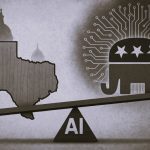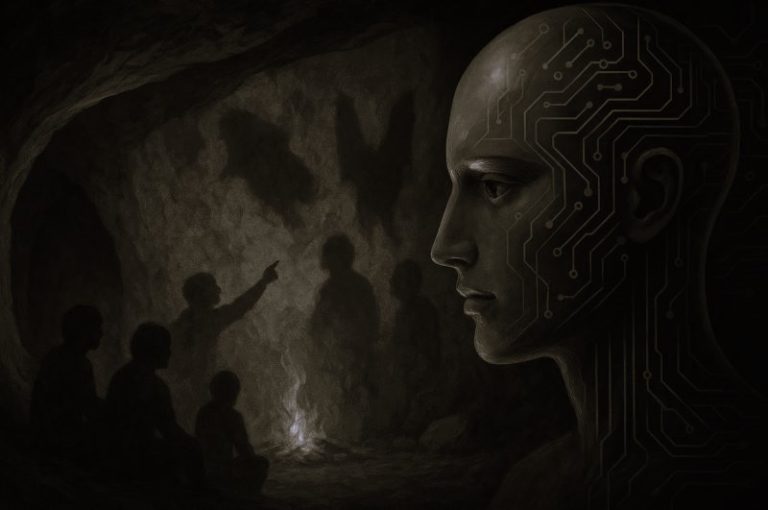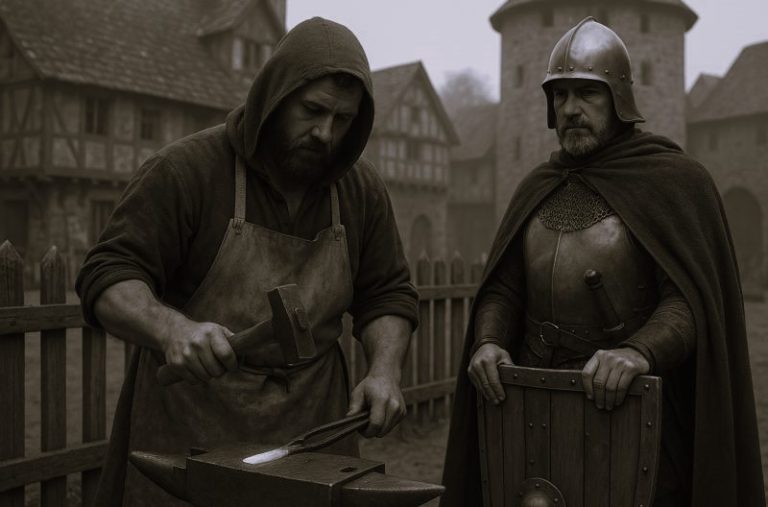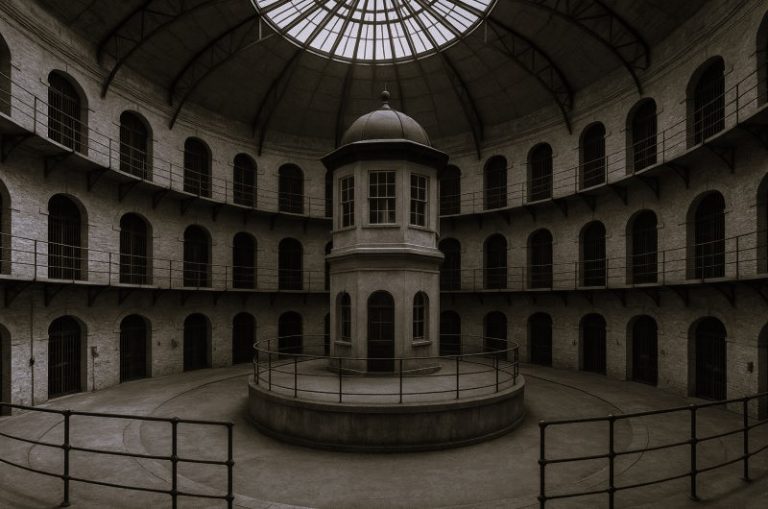A massive bulk cargo ship, the Pasha Bulker / Photo by Tim J. Keegan, Creative Commons
By Guglielmo Piombini / 10.19.2017
Before the State
For a very extended period of time primitive men lived in small groups of hunters and gatherers at a time in which there was no state. The modus vivendi of these clans was such that after having exhausted all nature-given resources in a particular area, they would move elsewhere in search of other available food supplies. This system of nomadic life could endure as long as the human race was limited and the vast majority of land remained uninhabited. Yet, this lifestyle was not sustainable, and within a short period of time the intensification of these hunting activities provoked an ecological crisis that spread across Europe, the Middle East and America, causing the extinction of 32 animal species [that had been an important food source].
The disappearance of the megafauna inaugurated, around the year 10,000 B.C. the transition to a mode of production based on agriculture. The Neolithic revolution could in fact be described as the pragmatic response to the exhaustion of resources that resulted from the intensified exploitation of the system based on hunting and gathering. Even though the lives of the farmers were admittedly harder than those of the hunters, requiring long and heavy hours of labor in the fields, the sedentary life of the village made it possible for a far greater number of mouths to be fed: thanks to appropriations and to the cultivation of land, the human population increased considerably, giving birth to the first civilizations.
The Violent Origins of the State
According to historian William Durant:
Agriculture teaches men pacific ways, inures them to a prosaic routine, and exhausts them with the long day’s toil; such men accumulate wealth, but they forget the arts and sentiments of war. The hunter and the herder, accustomed to danger and skilled in killing, look upon war as but another form of chase, and hardly more perilous, when the woods cease to give them abundant game, or flocks decrease through a thinning pasture, they look with envy upon the ripe fields of the village, they invent with modern ease some plausible reason for attack, they invade, conquer, enslave and rule.
The first states emerged when these nomadic tribes of hunters and herders understood that the systematic exploitation of agricultural villages through taxation constituted a far more efficient and lucrative system than the old one of plunder and extermination. That the state was born in a brutal fashion is confirmed by every historical and anthropological research. On this matter, Friedrich Nietzsche wrote:
a race of conquerors which, aggressive, powerful and organized, pounces with its most horrid claws on an unsuspecting population, one which in numbers may be tremendously superior, but is still undisciplined and nomadic. Such is the origin of the ‘”state.”
According to Sociologist Lester Ward,
The state as distinct from tribal organization begins with the conquest of one race by another.
Similarly, wrote the Austrian general and sociologist Gustav Ratzenhofer,
Violence is the agent which has created the state.
and as Franz Oppenheimer observed,
Everywhere we find some warlike tribe breaking through the boundaries of some less warlike people, settling down as nobility, and founding its state.
The concept of State above mentioned is meant in a sociological, rather than in a political sense. In the field of political science one intends the state to be a particular type of political organization that emerged in Europe at the end of the middle ages. According to the more generic definition used in sociology, instead, one talks about the existence of a state whenever society is divided in two distinct classes: a productive majority who gets by through the employment of economic means (production and exchange) and a ruling elite who gets by through the employment of political means (taxation and expropriation). The typical order of a state and the inevitable division in social classes which defines it emerge simultaneously, according to sociologist Franz Oppenheimer, in that very crucial historical instant in which for the first time the conqueror decides to save the conquered from immediate annihilation in order to exploit him permanently in the years to come.
The Struggle between Merchants and Bureaucrats Begins
From that moment onwards, writes the anthropologist Marvin Harris, producers have precipitated in a dramatic condition of servitude from which they have never really escaped:
For the first time there appeared on earth kings, dictators, high priests, emperors, prime ministers, presidents, governors, mayors, generals, admirals, police chiefs, judges, lawyers, and jailers, along with dungeons, jails, penitentiaries, and concentration camps. Under the tutelage of the state, human beings learned for the first time how to bow, grove, kneel and kowtow. In many ways, the rise of the state was the descent of the world from freedom to slavery.
The birth of the state was then accompanied by a real class struggle between producers and bureaucrats, a struggle which to a great extent remains alive to this day: while the first group desires to keep the fruits of its own labor, the second aspires to come into possession of those fruits through force and inaugurate a system of rule and exploitation. The eternal conflict throughout history is therefore that between men of freedom and men of administration, between social power on the one hand and state power on the other. As will be illustrated in the examples that follow, the progress or decadence of civilization are determined by the trend of this struggle.
Societies of Bureaucrats
1. The Ancient Empires
Since the early days of recorded History, the great majority of people lived miserably under the most tyrannical empires (the Babylonian, Egyptian, Chinese, Persian, Indian, Late-Roman, Arab, ottoman, Incas, Aztec) which extended themselves across large areas. In these ancient empires progress was so slow as to go unnoticed and the reasons for such stagnation were the following: Political power in those empires did not have any need to innovate, rather innovation was fought due to the fear that new discoveries would disrupt the established system; the bureaucratic and military elite that ruled used to come into possession, through force, of every surplus of production repressing every small sign of resistance; every autonomous social force was nipped in the bud and nothing escaped the control of the despot who was the absolute owner of all goods of the reign and of all its inhabitants; finally the people were submitted not only to a confiscatory level of taxation but to forced labor for the construction of grandiose public works such as canals, city walls, pyramids and buildings.
These ancient empires were agglomerates of illiterate peasants who toiled from the morning to the night just to be able to provide for themselves vegetables without protein. Not surprisingly, they were not in a much better condition than their oxen, and at the same time they were completely subjugated to the commands of their superiors who could read and who were the only ones possessing the right of manufacturing and using war like instruments. The fact that these societies have lasted thousands of years sounds like a severe warning: there is no intrinsic force to human activities that can assure material and moral progress.
2. A Perfect Example: the Chinese Empire
The millenary empire of China can serve as a typical example of a closed society, that was completely dominated by a cast of intellectuals and bureaucrats. As the greatest historian of ancient China, Etienne Balasz, has explained, the Confucian state was decisively totalitarian. No private initiative was allowed and no expression of the public life could escape official regulation: clothing, private and public constructions, music, parties, and even the colors that one was allowed to wear were subject to the rigid control of the state. In addition, there were prescriptions of birth and death and the state surveilled with terrifying attention every step of its subjects, from the cradle to the grave.
China in the days of the mandarins was an environment of changeless patterns, routines, characterized by traditionalism and immobility and therefore suspicious towards any possible kind of innovation and initiative, let alone free research and entrepreneurship. The ingenious and inventive spirit that was not foreign to the Chinese would have doubtlessly enriched the country, but it was the state that impeded the country to embark upon an age of technical progress and economic development, by crushing every kind of private initiative just because it was thought to collide with the interests of the bureaucratic cast.
It is not surprising that throughout Chinese history technical and economic progress have coincided only with those phases of relative weakness of the central power, like in the period of the warring states (453-221 B.C), probably the richest and most brilliant of all Chinese history, or the period of the three reigns (220-280 A.D.). Even after 907 A.D. when the Tang dynasty collapsed and the period of endless wars for supremacy began, during the so-called period of the five dynasties and the five reigns, the country experimented a striking explosion of inventions and prosperity due to the lack of centralization.
3. A Modern Case: The Soviet Union
In our epoch, communist regimes have brought back, albeit in a bloodier form, the totalitarian control that was so characteristic of the ancient oriental despotisms. Marxist ideology with its radical hostility towards property, commerce and free enterprise, revealed itself to be the most suitable paradigm in satisfying the will to power of the parasitic classes. In every country where the political and bureaucratic classes have sought to destroy the productive sector, they have found it useful to uphold Marxist ideology as their mantra.
The extreme exploitation perpetrated by the communist bureaucracies against the productive classes, which in the case of the kulaks reached the stage of physical extermination, was denounced by Lev Trotzkij, Ante Ciliga, Milovan Gilas, Mihail Voslensky. Yet the most penetrating and most insightful analysis of the bureaucratic exploitation that took place under communism has come to us from the works of Bruno Rizzi, an ingenious, self-taught Italian scholar. Rizzi was arguably the first to comprehend that a parasitic class of bureaucrats had taken power in 1917, composed as he wrote of “state officials, policeman, writers, union mandarins and all the communist party in block” that kept plundering the workers in the most ferocious way ever to be seen.
The post-1917 Soviet State, Rizzi noted, had been drastically inflated. The bureaucrats with their respective families constituted a mass of 15 million people who had stuck to the upper levels of the administrative throne with the only job of sucking a great portion of the national product. In the Kolchoz, the state owned agricultural enterprises, only 37% of production remained in the hands of the workers, while the remaining went to the state who then turned it over to the bureaucracy. State functionaries, in addition, continuously made deals at the expense of ordinary citizens by fixing wages and prices for various products and by treating the “workers” as its “forced clients”, obliging them to acquire products in state owned stores with a markup that at times reached 120%.
Officials of the state in addition, obtained notable advantages by being able to destine many of the accumulated capital funds, set aside for the construction of public works, in projects that went to the exclusive benefit of their own class, a lucid example being the headquarters of the bureaucracy, the sumptuous 360 meter’s tall house of the soviets (the workers, meanwhile, had to cope with a home that was 5 meters squared on average). By having total control of the economic levers, guaranteed by an extremely invasive police state in the USSR, the bureaucracy was really omnipotent and every action on her part was aimed at maintaining its political hegemony and its well-established economic privileges.
Societies of Merchants
1. The Phoenicians and the Greeks
Around the year 1200 B.C. the empires of the bronze age (the Egyptian, Minoan, Mycenaean, Hittite and Assyrian empires) succumbed into a period of stagnation caused by the progressive suffocation of productive and mercantile activities. The crisis of the central powers gave freedom of action to certain commercial people in the Middle East coming mainly from modern Lebanon, who, with their ships, began to sail the sea transporting goods and products of any kind. For the first time in history one saw the development, in the Mediterranean basin, of a catallactic system based on an integrated division of labor where markets and ports began to grow up to the point of becoming established cities. Commerce soon became the fly wheel of innovation: The Philistines invented iron; the Canaanites the alphabet; the Phoenicians discovered glass and at the same time improved boats, navigational knowledge and accounting systems.
“In truth, writes Matt Ridley, was there ever a more admirable people than the Phoenicians?” Those ancient merchants connected not only the entire Mediterranean, but also the accessible coasts of the Atlantic, the Red Sea and the overland routes of Asia, and yet they never had an emperor and never participated in a memorable battle. In order to prosper the Phoenician cities of Tyre, Byblos, Sidon, Carthage and Gadir did not feel the need of uniting into a single political entity, and therefore never went beyond a very modest federation.
In the words of Matt Ridley:
The Phoenician diaspora is one of the great untold stories of history- untold because Tyre and its books were so utterly destroyed by thugs like Nebuchadnezzar, Cyrus and Alexander, and Carthage by the Scipios, so the story comes to us only through snippets from snobbish and envious neighbors.
Even the Greek miracle confirms the important lesson, first formulated by David Hume, that political fragmentation, by putting a break on the extension of political power, is the real ally of economic progress. The extraordinary dissemination of prosperity and of Greek culture between the years 600 B.C. and 300 B.C presents us with a development similar to that of the Phoenician cities: Miletus, Athens and the other hundred independent cities of Magna Grecia, enriched themselves through the extension of commercial relationships without being part of a single empire. Furthermore, the circulation of ideas that the increased trade made possible, gave birth to the grandiose discoveries of the time. The lesson of the Greek miracle is the following: It is always the merchant who opens the door to the philosopher, not the other way around, by enriching the city and opening it, through foreign trade, to new ideas. Unfortunately, this period of Greek enlightenment died out as soon as new empires began to ascend: first the Athenian, then the Macedonian, and ultimately the Roman.
2. The Communes of Medieval Europe
The fall of the Roman Empire in 476 A.D. represented the luckiest event in the history of the old continent. Thanks to circumstances that one could describe as miraculous, Europe never returned to being a unified political entity, after the repeated failures of Charlemagne and the Germanic emperors. The lack of political unity enabled a widespread social experimentation that unleashed into a creative competition between thousands of independent political units of which the byproduct was rapid economic, social and cultural progress. The weakness of the central authority favored the cities which became the leaders in the 11th century of a political and commercial revolution that would mark the European institutional setting for centuries to come. In fights that lasted even hundreds of years, the inhabitants of the cities escaped the dominion of emperors and feudal lords, rebuilding society through self-government from the bottom up. The inhabitants of these communes oriented themselves toward the economy and not toward politics because, unlike those of the ancient cities they lacked a great mass of slaves at their disposal: they found themselves forced to abandon predation (which had been the common means of increasing one’s own well-being up to those days) and engage in manufacturing activities and commerce. In this manner, the medieval bourgeois extended the market economy beyond the limits of the feudal world and by the year 1200 A.D. Europe was a region inundated by working men, farmers, entrepreneurs, artisans and merchants who exchanged the fruits of their own labor at the many annual fairs: this was a very different scenario from the one that prevailed in other areas of the civilized world, where the masses continued to be subjugated by omnipotent imperial bureaucracies.
3. 3 Modern Cases: Holland, England, and the United States
In the 17th century the incredible success of the little country of Holland and the disastrous ruin of the Spanish empire, stands to confirm, in the eyes of contemporary historians, the superiority of the commercial society over the bureaucratic one. In Spain, during those years, a new anti-bourgeois ideology had developed among its elite, an ideology that saw with great scorn and contempt the accumulation of wealth through value enhancing work. The Spanish bureaucratic state as a consequence began to be directed by men who were completely foreign to the world of economics and business and who pushed the country into adopting economic policies that played out to be a disaster for commerce and industry.
In the United Provinces at the time, matters were different. Laissez-faire was a consolidated and fully legitimized praxis, and the success that Holland derived from the adoption of free trade caused a mix of admiration, amazement, and envy all around Europe. In 1670, the Dutch were by far the biggest players in the international trade arena to the point that their merchant navy was bigger and mightier than those of France, Scotland, Germany, Spain and Portugal put together. Holland, in the 1600s was a laboratory in which one could observe and study the capitalistic and bourgeois society in its purest form. Its example showed the path toward self-propelled development: ignoring the Dutch reality meant condemning oneself to continued stagnation.
The English were the first to understand how the prosperity of Holland was closely connected to the liberty that individuals and economic agents enjoyed over there, and it was by imitating the Dutch, that they began to build the basis of their world supremacy. In the 19th century then, England adopted unilaterally a series of measures that opened its harbors to the rest of the globe and such a drastic and unprecedented move provoked a reduction of custom tariffs in all major countries, via a competitive process. Finally, humanity was able to experience the birth of a free and authentic market economy that operated internationally: a Phoenician experiment on a planetary scale. Each country that participated in this international division of labor benefited, and this is shown by the fact that the world economy throughout this period grew by 3 times. But It was in the two most free-market countries, namely England and the United States, where economic growth surpassed by far that of the rest of the world: from 1820 to 1913 the gross domestic product of England increased six-fold, while the American one grew by 41 times.
Decisive for the success of Victorian England and the young United States, according to economic historian Deirdre McCloskey, was the consolidation at the social level in those years of a bourgeois mentality that praised and honored the common man who created his fortune through work, commitment, creativity and ingenuity. Nothing probably better symbolizes the cultural victory of the productive classes of society than the statue placed in Westminster abbey in 1825 in honor of James Watt, inventor of the steam engine.
For a Libertarian Historiography
One can therefore see how the great intellectual and material creations that have elevated human civilization through the ages have not been the product of bureaucrats, but of producers, merchants, entrepreneurs, some of whom have been obscured, exploited, mistreated and others who have simply been forgotten. The protagonists of human development are not the emperors, kings, presidents, ministers or generals who most often appear in our conventional history books, but the farmers, artisans, entrepreneurs and merchants who improved the many arts, techniques and professions. The bravest among these have defended freedom and civilization arms in hand, refusing to be subjugated by the powers of their day.
The common thread in human history is the endless conflict between tax payers and tax consumers which brings us to the following conclusion: Libertarian scholars should narrate historical events through the lenses of those men who represented the ideas of freedom, not those of power. Civilization, ought to be remembered, has been edified by those men who have resisted power, not by those who have exercised it.










